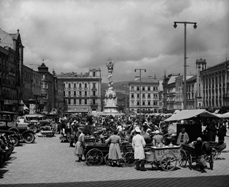Economy

Above all, Austria's inter-war economy was hampered by changing political events. The collapse of the monarchy cut the country off from sources of natural resources and energy on the one hand, and markets on the other. The inflation that followed the end of the First World War gave the semblance of economic growth, but the stabilisation of the currency exposed the economy's structural weaknesses. After a short period of respite during the first half of the 1920s, the global depression led to great difficulties, and closures, for many companies.
National Socialist economic planning gave Linz a new status: Linz was to become a centre for industry as well as a transport hub of the first rank. To fulfil these aims, heavy industry was set up, including the Hermann-Göring-Werke, serving mainly the arms industry. These expansion plans, which were increasingly scaled down as the war went on, also included new dockyards and improved connections to the rail and motorway networks.
Back to the list of contents "Linz between Democracy and Dictatorship 1918-1945"